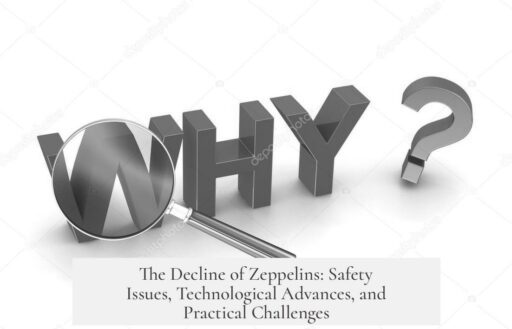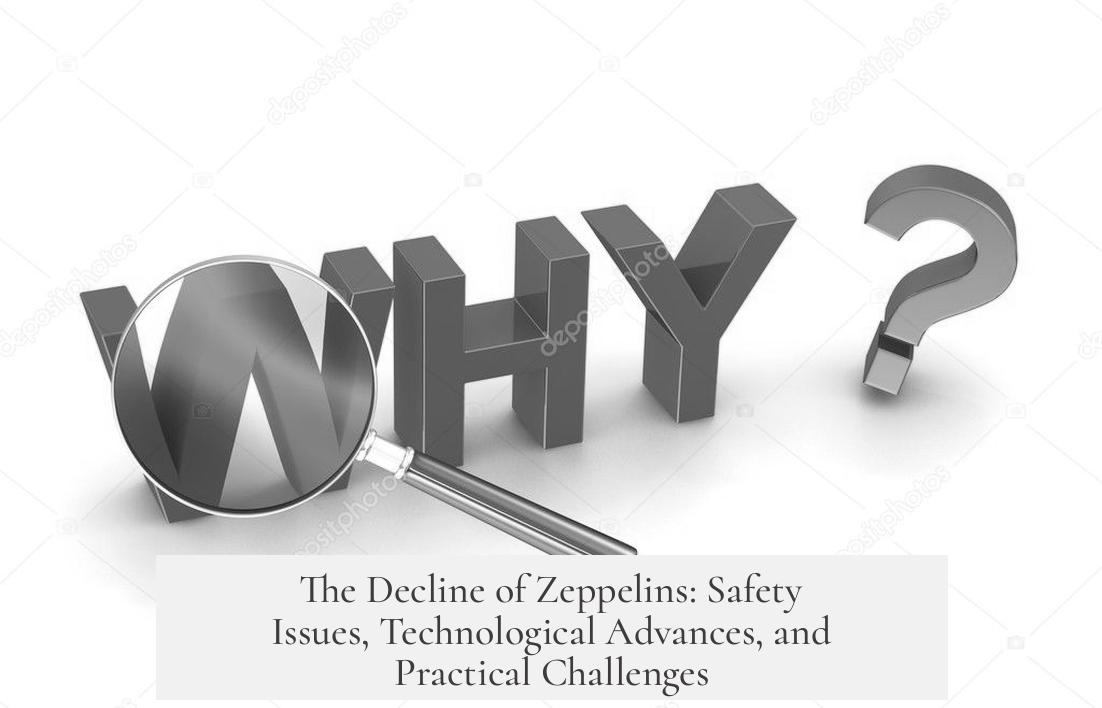Zeppelins are no longer used mainly because of safety issues, technological advances in airplanes, military restrictions, and practical limitations. The 1937 Hindenburg disaster severely damaged public trust in zeppelins as safe passenger transport. The rise of reliable, faster airplanes replaced the need for slower, vulnerable airships. Military bans and logistical challenges hastened their decline. Despite a few niche modern uses, Zeppelins are now largely obsolete.
The Hindenburg disaster profoundly changed public perception. This fiery crash during a highly publicized transatlantic flight showed how dangerous hydrogen-filled zeppelins were. The media coverage made zeppelins synonymous with catastrophic failure. After that, companies abandoned passenger travel by Zeppelin since the public no longer trusted their safety. The accident made zeppelins a historical curiosity rather than a practical transport option.
This disaster was not the only reason. During World War I and II, advancements in airplane technology greatly outpaced airships. Early planes were small and fragile but evolved into large, powerful bombers and transports by WWII. Airplanes proved faster, more reliable, and easier to defend militarily. They needed less ground infrastructure and could operate in weather conditions that would ground zeppelins. This made airplanes clearly more effective for both military and commercial use.
Many countries mastered airplane production, which accelerated the shift away from zeppelins. By WWII, it was obvious airplanes were the future of air travel because they were aerodynamic and structurally more resilient. In contrast, zeppelins were large, slow, and vulnerable to wind and weather. They required huge hangars and complex ground teams for operations.
Another major factor was military restrictions and political decisions. After WWI, the Treaty of Versailles banned Germany from developing airships as military weapons. Many existing vessels were dismantled as reparations, reducing the fleet steadily. Also, the politics of the Luftwaffe played a role. Hermann Göring, head of the German air force, disliked zeppelins and ordered the destruction of all production facilities by 1940. This political opposition slowed any possible development.
Safety concerns extended beyond the Hindenburg. While the US had access to non-flammable helium, most nations did not. The shift of key materials like aluminum for war production limited airship construction. The absence of helium made hydrogen the default lifting gas, which was highly flammable. This risk added to the negative image of zeppelins. Inflatable structure maintenance, susceptibility to storms, and the risk of catastrophic fire made them too risky for passengers.
Practical limitations also hinder their viability. Zeppelins move slowly and need massive ground crews and facilities. Hangars must be enormous, and operations require calm weather due to airships’ sensitivity to crosswinds. Loading them into hangars during windy conditions risks severe damage. The payload capacity remains relatively low compared to the infrastructure needed, limiting economic feasibility. This makes zeppelins inefficient compared to airplanes and railways for cargo or passengers.
Despite these historical hurdles, zeppelins have not completely vanished. Some companies, especially in Germany, have tried to revive airship technology for specialized tasks. Modern airships use helium and sometimes hybrid designs. They offer vertical takeoff and landing (VTOL) without runways. Advances in solar power and fuel cells theoretically allow for long endurance flights, useful for scientific research, communication platforms, or tourism. For instance, Goodyear now operates airships made by the Zeppelin company, though these are semi-rigid designs, not classic zeppelins.
Still, these uses are niche and do not challenge airplanes in general transport. Airships remain useful primarily for roles where endurance and low operational costs outweigh speed. Examples include atmospheric observations, marketing events, and luxury sightseeing tours. Autonomous solar-powered airships could extend their applications in the future, filling gaps in satellite communications. But broad passenger or cargo use is unlikely due to cost and practicality issues.
In essence, zeppelins are no longer mainstream because they cannot compete with modern aircraft. Safety concerns from historical accidents, combined with higher speeds and capabilities of airplanes, military bans, political opposition, helium scarcity, and extensive infrastructure needs sealed their fate. While new innovations keep airships alive in specialized fields, classic zeppelins belong to history.
- The Hindenburg disaster destroyed public trust in zeppelins as safe transport.
- Advances in airplanes rendered airships slow, vulnerable, and inefficient.
- Military bans and politics stopped zeppelin production, especially in Germany.
- Safety risks with hydrogen and helium scarcity limited airship use.
- Operational demands and weather sensitivity made zeppelins impractical.
- Modern airships exist but serve niche roles like research and marketing.
- Zeppelins lost relevance as airplanes became dominant for transport.
Why Do We No Longer Use Zeppelins?

Simply put, we stopped using Zeppelins because they became wildly unsafe, technologically outdated, and downright impractical. The infamous Hindenburg disaster was the nail in the coffin, but many other factors led to their demise in mainstream travel and military use.
Let’s unpack this story, one floating giant at a time. The rise and fall of the Zeppelin is a fascinating chapter in aviation history filled with drama, innovation, and a splash of bad luck. Why did these majestic airships, once symbols of progress and luxury, vanish from the skies? The answer isn’t just one event but a tide of circumstances that pushed the Zeppelin out of the spotlight for good.
The Hindenburg Disaster: A Flaming Spectacle That Changed Everything
Imagine the excitement when the Hindenburg set out on transatlantic flights, impressing media and the public alike. All the glamour and buzz evaporated in seconds when the airship burst into flames—live on camera—turning a high-profile success story into a public relations nightmare. From that moment, the Zeppelin was no longer just a mode of transport; it was a cautionary tale.
Transporting passengers by Zeppelin just wasn’t on the table anymore. The disaster burned away public confidence and unveiled the inherent danger of using hydrogen as the lifting gas. Despite attempts to spin the story, the association with fiery doom stuck. If you wanted to start a Zeppelin travel company today, you would be up against a mountain of skepticism and the legacy of what many still see as a colossal mistake.
The Technological Leap: Airplanes Fly Past the Zeppelin’s Glory
While Zeppelins floated elegantly in the skies, airplanes were rapidly transforming. During and after World War I, aviation technology took giant steps forward. Small fighters gave way to bigger bombers and transport planes. By World War II, airplanes dominated not just military but commercial aviation as well. Why? Because they were faster, more reliable, and didn’t need massive ground support.
Let’s be honest: planes do everything a Zeppelin can do—only better. They are aerodynamic, quick to take off and land, and able to carry more passengers or cargo at higher speeds. The concept of helium-filled airships sounded great until airplanes proved they could beat them on practicality and efficiency. Helicopters added vertical takeoff and landing, filling gaps Zeppelins could never manage.
Once the aviation industry recognized that planes were simply better for most purposes, Zeppelins were pushed to the sidelines. Sort of like how CDs replaced VHS tapes—and very few people want to go back.
Military Restrictions Pulled the Plug Early
The decline started long before the Hindenburg. Post-World War I treaties viewed Zeppelins as potential terror weapons and banned their military development in Germany. Production stopped, existing airships were scrapped, and innovation stalled. Why? Because if it had no military use, aerospace industries often ignored it, favoring technologies that proved their worth on the battlefield.
With military funding and interest drying up, the Zeppelin’s future grew dim. The military’s lukewarm attitude toward these giants shaped their commercial demise. Starving for advancement and investment, the once-promising airship couldn’t keep pace with faster, more tactical aircraft.
Safety and Helium: A Gas You Can’t Take for Granted

The Hindenburg used hydrogen, which burns fiercely—hence the spectacular disaster. But the US held a secret weapon: helium. The only country with large helium reserves could manufacture much safer airships. Despite this advantage, wartime priorities diverted helium supplies, and production struggled.
Even with helium, airships weren’t the safest or most practical way to travel. The massive hangars needed, vulnerability to weather, and operational complexities meant Zeppelins couldn’t shake their reputation as “floating risks.” Few countries had the helium or resources to keep them flying safely. And when the war demanded aluminum for airplanes instead of airships, the Zeppelin was sidelined even further.
Practical Limitations: Slow, Wind-Sensitive, and Infrastructure-Hungry
Think about how slow Zeppelins were. They cruised at speeds airplanes easily surpassed. They hated bad weather, especially strong winds, which could rip them apart when moored. The hangars alone had to be enormous and perfectly shielded from crosswinds—something no airport runway has to worry about.
The actual payload? Tiny compared to the infrastructure demands. Big ground crews, massive facilitator costs, and a fragile design made Zeppelins borderline obsolete after airplanes got bigger and bolder in the mid-20th century. To put it simply, they were slow, huge, delicate, and required an army just to get off the ground.
Internal Politics: When Power Players Say “No”
And here’s the kicker: even inside Germany’s Luftwaffe, there was no love for Zeppelins. Hermann Göring, head of the Luftwaffe, wasn’t a fan and ordered all production and existing crafts destroyed in 1940. With political power behind technological choices, Zeppelins didn’t stand a chance within military circles, further dooming their future.
A Modern Day Zeppelin? Not Quite Dead Yet
Surprise! Zeppelins aren’t entirely extinct. In recent decades, firms have tried reviving them on a smaller scale. Some use modern airships for niche jobs like climate research, marketing stunts, or tourist flights—applications airplanes can’t easily match. Their ability to hover or perform vertical takeoff and landing (VTOL), combined with new solar power and fuel cell tech, makes them interesting alternatives to satellites for communications.
Goodyear, for instance, is transitioning to a new airship fleet built by the Zeppelin company. Not classic Zeppelins, but close cousins, these semi-rigid airships find use in advertising and surveillance. It shows that the technology itself isn’t obsolete across the board; it’s just outclassed for passenger travel.
So, Why Don’t We Use Zeppelins Anymore?
To sum it all up: Zeppelins fell out of favor due to the Hindenburg disaster’s reputation damage, rapid technological advancements in airplanes, severe practical limitations, military restrictions, and safety concerns with lifting gases. Each factor stacked against these giant airships, making them impractical for mass transportation or military use.
Of course, for enthusiasts and specialized uses, Zeppelins still glide quietly across the sky now and then. But for the everyday passenger looking to cross an ocean, the Zeppelin is a floating relic—an elegant but flawed dream overtaken by jets roaring above.
Is there room for Zeppelins in the future? With modern technology and green energy, possibly. But it’s an uphill climb against efficiency and speed. Sometimes the past has charm but belongs in history books more than airports.



